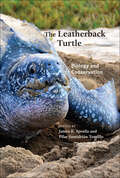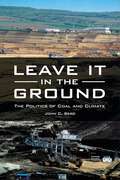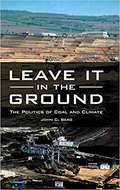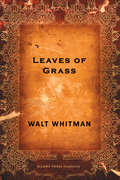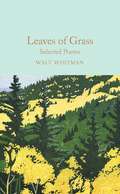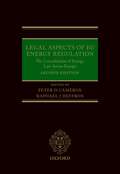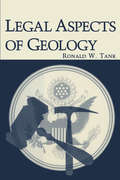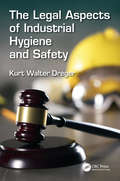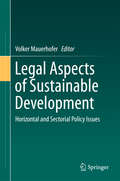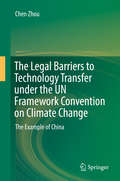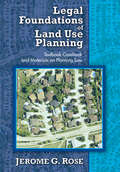- Table View
- List View
The Leatherback Turtle: Biology and Conservation
by James R. Spotila Pilar Santidrián TomilloWeighing as much as 2,000 pounds and reaching lengths of over seven feet, leatherback turtles are the world’s largest reptile. These unusual sea turtles have a thick, pliable shell that helps them to withstand great depthsâ€�they can swim more than one thousand meters below the surface in search of food. And what food source sustains these goliaths? Their diet consists almost exclusively of jellyfish, a meal they crisscross the oceans to find. Leatherbacks have been declining in recent decades, and some predict they will be gone by the end of this century. Why? Because of two primary factors: human redevelopment of nesting beaches and commercial fishing. There are only twenty-nine index beaches in the world where these turtles nest, and there is immense pressure to develop most of them into homes or resorts. At the same time, longline and gill net fisheries continue to overwhelm waters frequented by leatherbacks. In The Leatherback Turtle, James R. Spotila and Pilar Santidrián Tomillo bring together the world’s leading experts to produce a volume that reveals the biology of the leatherback while putting a spotlight on the conservation problems and solutions related to the species. The book leaves us with options: embark on the conservation strategy laid out within its pages and save one of nature’s most splendid creations, or watch yet another magnificent species disappear.
Leave It in the Ground: The Politics of Coal and Climate
by John C. BergEmploying scientific explanations and hard data, this book shows why coal is such a problem, how the pro-coal forces got to be so powerful, and how those forces might be defeated through political activism.Coal provided the energy to build modern civilization. This energy source raised standards of living, multiplied the earth's population, and enabled people in developed countries to enjoy leisure time. Today, we know that if we burn all the coal available, climate change will continue to increase. But the use of coal isn't purely an environmental issue; there are also political and economic forces at play. This book examines the politics and environmental impact of coal production and distribution, presenting a clear point of view—that we must shift away from coal use—backed by hard data and supplying specific prescriptions for opposing and regulating the coal industry.Author John C. Berg explains how ending the burning of coal (and of oil and natural gas) is a political problem rather than a technical one; explodes the "clean coal" myth, providing scientific documentation of how burning coal emits more greenhouse gases per unit of energy than any other fuel; and describes how controlling coal use in the United States will also serve to restore the possibility of a meaningful international climate agreement. Additionally, readers will understand the critical importance of activism—from local to international—in spurring government regulation to control the coal industry, which can only be defeated politically.
Leave It in the Ground: The Politics of Coal and Climate
by John C. BergEmploying scientific explanations and hard data, this book shows why coal is such a problem, how the pro-coal forces got to be so powerful, and how those forces might be defeated through political activism.Coal provided the energy to build modern civilization. This energy source raised standards of living, multiplied the earth's population, and enabled people in developed countries to enjoy leisure time. Today, we know that if we burn all the coal available, climate change will continue to increase. But the use of coal isn't purely an environmental issue; there are also political and economic forces at play. This book examines the politics and environmental impact of coal production and distribution, presenting a clear point of view—that we must shift away from coal use—backed by hard data and supplying specific prescriptions for opposing and regulating the coal industry.Author John C. Berg explains how ending the burning of coal (and of oil and natural gas) is a political problem rather than a technical one; explodes the "clean coal" myth, providing scientific documentation of how burning coal emits more greenhouse gases per unit of energy than any other fuel; and describes how controlling coal use in the United States will also serve to restore the possibility of a meaningful international climate agreement. Additionally, readers will understand the critical importance of activism—from local to international—in spurring government regulation to control the coal industry, which can only be defeated politically.
Leaves of Grass
by Walt WhitmanOriginally published as a collection of twelve poems in 1855, Leaves of Grass eventually grew to more than four hundred poems, as Walt Whitman continued to edit and add to the collection throughout his life.Celebrating life, humanity, and the material world, Leaves of Grass was considered obscene at the time of its publication because of its overt discussion of sensual pleasure. It is now considered to be among the greatest collections of poetry to be published in modern times.Be it mystery, romance, drama, comedy, politics, or history, great literature stands the test of time. ClassicJoe proudly brings literary classics to today's digital readers, connecting those who love to read with authors whose work continues to get people talking. Look for other fiction and non-fiction classics from ClassicJoe.
Leaves of Grass: Selected Poems (Macmillan Collector's Library #187)
by Walt WhitmanLeaves of Grass is Walt Whitman’s glorious poetry collection, first published in 1855, which he revised and expanded throughout his lifetime. It was ground-breaking in its subject matter and in its direct, unembellished style. Part of the Macmillan Collector’s Library; a series of stunning, clothbound, pocket sized classics with gold foiled edges and ribbon markers. These beautiful books make perfect gifts or a treat for any book lover. This edition is edited and introduced by Professor Bridget Bennett.Whitman wrote about the United States and its people, its revolutionary spirit and about democracy. He wrote openly about the body and about desire in a way that completely broke with convention and which paved the way for a completely new kind of poetry. This new collection is taken from the final version, the Deathbed edition, and it includes his most famous poems such as ‘Song of Myself’ and ‘I Sing the Body Electric’.
Leaving Space for Nature: The Critical Role of Area-Based Conservation (Routledge Studies in Conservation and the Environment)
by Nigel Dudley Sue StoltonThis book provides the first contemporary assessment of area-based conservation and its implications for nature and society. Now covering 15 per cent of the land surface and a growing area of ocean, the creation of protected areas is one of the fastest conscious changes in land management in history. But this has come at a cost, including a backlash from human rights organisations about the social impacts of protected areas. At the same time, a range of new types of area-based conservation has emerged, based on indigenous people’s territories, local community lands and a new designation of “other effective area-based conservation measures”. This book provides a concise overview of the status and possible futures of area-based conservation. With many people calling for half the earth’s land surface to remain in a natural condition, this book taps into the urgent debate about the feasibility of such an aim and the ways in which such land might be managed. It provides a timely contribution by people who have been at the centre of the debate for the last twenty years. Building on the authors’ large personal knowledge, the book draws on global case studies where the authors have firsthand experience, including Yosemite National Park (USA), Blue Mountains National Park (Australia), Bwindi National Park (Uganda), Chingaza National Park (Colombia), Ustyart Plateau (Kazakhstan), Snowdonia National Park (Wales) and many more. This book is essential reading for students, academics and practitioners interested in conservation and its impact on society.
Leaving Space for Nature: The Critical Role of Area-Based Conservation (Routledge Studies in Conservation and the Environment)
by Nigel Dudley Sue StoltonThis book provides the first contemporary assessment of area-based conservation and its implications for nature and society. Now covering 15 per cent of the land surface and a growing area of ocean, the creation of protected areas is one of the fastest conscious changes in land management in history. But this has come at a cost, including a backlash from human rights organisations about the social impacts of protected areas. At the same time, a range of new types of area-based conservation has emerged, based on indigenous people’s territories, local community lands and a new designation of “other effective area-based conservation measures”. This book provides a concise overview of the status and possible futures of area-based conservation. With many people calling for half the earth’s land surface to remain in a natural condition, this book taps into the urgent debate about the feasibility of such an aim and the ways in which such land might be managed. It provides a timely contribution by people who have been at the centre of the debate for the last twenty years. Building on the authors’ large personal knowledge, the book draws on global case studies where the authors have firsthand experience, including Yosemite National Park (USA), Blue Mountains National Park (Australia), Bwindi National Park (Uganda), Chingaza National Park (Colombia), Ustyart Plateau (Kazakhstan), Snowdonia National Park (Wales) and many more. This book is essential reading for students, academics and practitioners interested in conservation and its impact on society.
Leaving the Lyrebird Forest
by Gary Crew'Are you lonely here?' her mother asked. 'Never,' Alice said. 'Not while I am friends with the lyrebird.'Alice has spent her life living on the outskirts of a small town, in a house nestled in bushland. Every other morning, she is visited by a lyrebird. Her bond with this magnificent bird brings her together with her nearest neighbour, Mr Brown, a widower who loves the bush and its treasures as much as she does.But change is coming: Alice is growing up, and having to think about her future (a future which might mean leaving the bush for her education). Mr Brown is getting older, and less able to look after himself. And as the nearby town grows, their beloved lyrebird and bushland are threatened too.A touching story that will resonate with readers everywhere, stunningly illustrated with woodcuts by acclaimed artist Julian Laffan.
Leben bleibt rätselhaft: Was wissen wir über die großen Fragen der Biologie?
by Andreas JahnDie ungeklärten Mysterien der BiologieWoher kommt das Leben? Warum schlafen wir? Wie können wir länger leben? Drei von sechs grundlegenden Fragen, die immer noch weitgehend offen sind und mit denen sich die moderne Biologie beschäftigt. Zu den ungelösten Mysterien zählen außerdem Evolution, Vererbung und Bewusstsein. Wie namhafte Wissenschaftler aus aller Welt versuchen, der Natur diese Geheimnisse Stück für Stück zu entlocken, beschreibt dieses Buch anhand ausgewählter Artikel aus den Zeitschriften "Spektrum der Wissenschaft" und "Gehirn&Geist". Meist sind es die Forscher selbst, die aus erster Hand ihre Beobachtungen und Entdeckungen schildern und somit Gelegenheit geben, ihnen über die Schulter zu schauen. Dabei sind sie sich längst nicht in allen Punkten einig. Der vorliegende Sammelband spiegelt den aktuellen Wissensstand, aber auch die zum Teil kontroversen Ansichten über die Wunder des Lebens wider.
Lebensraum Universum: Einführung in die Exoökologie
by Aleksandar JanjicDieses Buch führt in Fragestellungen der Astrobiologie und Exoökologie ein und vermittelt einen umfassenden Überblick über die aktuellsten Forschungsergebnisse, vergangenen Rückschläge und zukünftigen Missionen der führenden Raumfahrtorganisationen. Unter astrophysikalischen, geo- und bioökologischen Gesichtspunkten werden dem Leser exotische Welten und deren Bewohner präsentiert, welche unsere irdischen Vorstellungen auf den astronomischen Maßstab erweitern und das Phänomen Leben unter neuem Sternenlicht erstrahlen lassen.Werden wir in diesem Jahrhundert außerirdisches Lebensformen finden? Und nach welchen Biosignaturen auf fernen Himmelskörpern sollten wir suchen, um extraterrestrische Ökosysteme aufspüren zu können?
Lecture Notes on Resource and Environmental Economics (The Economics of Non-Market Goods and Resources #16)
by Anthony C. FisherThis book, based on lectures on natural and environmental resource economics, offers a nontechnical exposition of the modern theory of sustainability in the presence of resource scarcity. It applies an alternative take on environmental economics, focusing on the economics of the natural environment, including development, computation, and potential empirical importance of the concept of option value, as opposed to the standard treatment of the economics of pollution control. The approach throughout is primarily conceptual and theoretical, though empirical estimation and results are sometimes noted. Mathematics, ranging from elementary calculus to more formal dynamic optimization, is used, especially in the early chapters on the optimal management of exhaustible and renewable resources, but results are always given an economic interpretation. Diagrams and numerical examples are also used extensively.The first chapter introduces the classical economists as the first resource economists, in their discussion of the implications of a limited natural resource base (agricultural land) for the evolution of the wider economy. A later chapter returns to the same concerns, along with others stimulated by the energy and environmental “crises” of the 1970s and beyond. One section considers alternative measures of resource scarcity and empirical findings on their behavior over time. Another introduces the modern concept of sustainability with an intuitive development of the analytics. A chapter on the dynamics of environmental management motivates the concept of option value, shows how to compute it, then demonstrates its importance in an illustrative empirical example. The closing chapter, on climate change, first projects future changes and potential catastrophic impacts, then discusses the policy relevance of both option value and discounting for the very long run.This book is intended for resource and environmental economists and can be read by interested graduate and advanced undergraduate students in the field as well.
The Legacy of Nuclear Power
by Andrew BlowersNuclear energy leaves behind an infinitely dangerous legacy of radioactive wastes in places that are remote and polluted landscapes of risk. Four of these places - Hanford (USA) where the plutonium for the first atomic bombs was made, Sellafield, where the UK’s nuclear legacy is concentrated and controversial, La Hague the heart of the French nuclear industry, and Gorleben, the focal point of nuclear resistance in Germany - provide the narratives for this unique account of the legacy of nuclear power. The Legacy of Nuclear Power takes a historical and geographical perspective going back to the origins of these places and the ever changing relationship between local communities and the nuclear industry. The case studies are based on a variety of academic and policy sources and on conversations with a vast array of people over many years. Each story is mediated through an original theoretical framework focused on the concept of ‘peripheral communities’ developing through changing discourses of nuclear energy. This interdisciplinary book brings together social, political and ethical themes to produce a work that tells not just a story but also provides profound insights into how the nuclear legacy should be managed in the future. The book is designed to be enjoyed by academics, policy-makers and professionals interested in energy, environmental planning and politics and by a wider group of stakeholders and the public concerned about our nuclear legacy.
The Legacy of Nuclear Power
by Andrew BlowersNuclear energy leaves behind an infinitely dangerous legacy of radioactive wastes in places that are remote and polluted landscapes of risk. Four of these places - Hanford (USA) where the plutonium for the first atomic bombs was made, Sellafield, where the UK’s nuclear legacy is concentrated and controversial, La Hague the heart of the French nuclear industry, and Gorleben, the focal point of nuclear resistance in Germany - provide the narratives for this unique account of the legacy of nuclear power. The Legacy of Nuclear Power takes a historical and geographical perspective going back to the origins of these places and the ever changing relationship between local communities and the nuclear industry. The case studies are based on a variety of academic and policy sources and on conversations with a vast array of people over many years. Each story is mediated through an original theoretical framework focused on the concept of ‘peripheral communities’ developing through changing discourses of nuclear energy. This interdisciplinary book brings together social, political and ethical themes to produce a work that tells not just a story but also provides profound insights into how the nuclear legacy should be managed in the future. The book is designed to be enjoyed by academics, policy-makers and professionals interested in energy, environmental planning and politics and by a wider group of stakeholders and the public concerned about our nuclear legacy.
Legal Aspects of EU Energy Regulation
by Peter D Cameron and Raphael J HeffronThis book provides comprehensive coverage of EU energy law in practice, evaluating the effectiveness of the Third Energy Package, the rise and importance of national and EU renewable energy measures in electricity markets, interconnection and infrastructure aspects of the electricity and gas markets. The national reports take into account the legal and institutional diversity among the Member States, drawing on the experience of prominent energy lawyers to provide analyses of their own national experiences. This book includes an overview of the Energy Union, the institutional framework of regulation, a comprehensive review of how things have changed as a result of the various energy packages, state aid decisions and Energy Charter and European Court of Justice case law.
Legal Aspects of EU Energy Regulation
This book provides comprehensive coverage of EU energy law in practice, evaluating the effectiveness of the Third Energy Package, the rise and importance of national and EU renewable energy measures in electricity markets, interconnection and infrastructure aspects of the electricity and gas markets. The national reports take into account the legal and institutional diversity among the Member States, drawing on the experience of prominent energy lawyers to provide analyses of their own national experiences. This book includes an overview of the Energy Union, the institutional framework of regulation, a comprehensive review of how things have changed as a result of the various energy packages, state aid decisions and Energy Charter and European Court of Justice case law.
Legal Aspects of Geology
by Ronald W. TankThis treatise is an outgrowth of a series of seminars and tutorials on selected legal aspects of geology that were offered to several generations of undergraduate students at Lawrence University. The offerings were in response to a keen interest in how the law and legal institutions relate to the professional geologist. Much of the student interest was undoubtedly sparked by the legal controversies as sociated with the "environmental movement" that became so active during the 1970s and continues today to look to the law for the resolution of conflicting goals. Other students were interested in the role allocated to law by society in general, or were simply curious about law as a profession. Existing published material did not meet my needs, and I had to rely on "handouts" summarizing legal principles, reported appellate cases, and guest lectures from the county bar association. The more formally prepared course materials were edited by practicing attorneys and scholars in academia who encouraged me to seek a publisher who might make the materials available to a broader audience-an audience that might include not only students of the law but also the professional geologist, geological engineers, planners, policy makers, and attorneys, whether in industry, government, education, or private practice, who want to know more about the relationship between law and geology.
The Legal Aspects of Industrial Hygiene and Safety (Sustainable Improvements in Environment Safety and Health)
by Kurt W. DregerThe Legal Aspects of Industrial Hygiene and Safety explores various legal issues that are often encountered by Industrial Hygiene and Safety managers during their careers. A description is presented of the various legal concepts and processes that often arise in the IH/S practice, including tort, contract, and administrative law. The goal is to provide IH/S managers with sufficient knowledge to be able to incorporate legal risk analysis into everyday decision-making and policy development. This book will explore the legal issues that arise in IH/S practice and will be helpful to new IH/S managers as they progress in their careers. FEATURES Explores various legal issues that are often encountered by Industrial Hygiene and Safety managers during their careers Provides insight into the legal issues and processes to IH/S managers that are traditionally only available to attorneys Improves the IH/S managers' ability to communicate complex IH/S issues to in-house counsel Presents tools and knowledge to IH/S managers so they can better consider the legal risks of the decisions they make Covers various legal concepts and processes that can arise in the IH/S practice, including tort, contract, and administrative law
The Legal Aspects of Industrial Hygiene and Safety (Sustainable Improvements in Environment Safety and Health)
by Kurt W. DregerThe Legal Aspects of Industrial Hygiene and Safety explores various legal issues that are often encountered by Industrial Hygiene and Safety managers during their careers. A description is presented of the various legal concepts and processes that often arise in the IH/S practice, including tort, contract, and administrative law. The goal is to provide IH/S managers with sufficient knowledge to be able to incorporate legal risk analysis into everyday decision-making and policy development. This book will explore the legal issues that arise in IH/S practice and will be helpful to new IH/S managers as they progress in their careers. FEATURES Explores various legal issues that are often encountered by Industrial Hygiene and Safety managers during their careers Provides insight into the legal issues and processes to IH/S managers that are traditionally only available to attorneys Improves the IH/S managers' ability to communicate complex IH/S issues to in-house counsel Presents tools and knowledge to IH/S managers so they can better consider the legal risks of the decisions they make Covers various legal concepts and processes that can arise in the IH/S practice, including tort, contract, and administrative law
Legal Aspects of Sustainable Development: Horizontal and Sectorial Policy Issues
by Volker MauerhoferThis book addresses legal aspects of sustainable development and offers the latest thinking on a wide range of current themes. By taking a cross-cutting approach, it adds considerably to the exploration of this emerging scientific field.Twenty-nine original contributions present innovative thoughts and replicable ideas from this exciting, new area, which will be of value to practitioners and researchers alike.These contributions are allocated into a horizontal and sectorial part. The section covering horizontal policies has five sub-parts: 1) general aspects; 2) human and intellectual property rights; 3) communication and social enterprise governance; 4) public participation and 5) assessment tools. The second part on sectorial policies also has five sub-parts: 1) forest and water management; 2) renewable energy; 3) cities, waste and material management; 4) biodiversity, nature conservation, oceans and spatial planning and 5) agriculture and rural policy.It offers a multifaceted discussion of sustainable development and law by authors from five continents and from both the public and the private sectors. This selection guarantees a broad view that presents the more theoretical arguments from the academic as well as the practical perspective.Furthermore, the authorship includes senior, highly experienced academics and practitioners as well as those at the start of their career. This ensures thoughtful expansions of established theories as well as the emergence of innovative ideas.Moreover, the ten sub-parts bring together likeminded thoughts, resulting in an exchange of different viewpoints on a similar theme. This allows the readers to concentrate on individual chapters, while at the same time discovering a variety of thoughts and ideas.
The Legal Barriers to Technology Transfer under the UN Framework Convention on Climate Change: The Example of China
by Chen ZhouThe book discusses climate technology transfer under the UNFCCC framework, and China’s relevant legislation and practices. It first explores theoretical basis of climate change-related technology transfer, with a particular focus on the differences between climate technology transfer and business-as-usual performance. The book then reviews practices of both technology supplier and user, in order to generally identify potential legal barriers and obstacles. Finally, it sheds light on China, providing a comprehensive assessment on barriers that hinder the trans-boundary transfers of low carbon technologies and need to be overcome in future. The issues concerned involve two of the most dynamic areas in current China’s lawmaking progress: environment laws and Intellectual Property laws. The book provides an in-depth analysis on China’s legislation and practices in this regard. At international level, the legal framework of climate technology transfer is examined in a systematic, prudent and constructive manner. On this basis, the book highlights potential commons, consistency and possible coordination between the UNFCCC and the WTO regime. This book is accessible to both Chinese and international environmental law specialists. It appeals to a broad readership, including environmental scientists, economists concerned with China’s intellectual property law, foreign investment law and anyone interested in the topic: how to green intellectual property rights regime for climate technology transfer in the China context.
Legal Challenges at the End of the Fossil Fuel Era: Shaping a Just and Clean Energy Transition (Global Issues)
by Daniel Iglesias Márquez Clara Esteve-Jordà Beatriz Felipe PérezThis edited collection proposes a wide range of approaches to address the legal issues pertaining to the end of the fossil fuel era. While the fossil fuel era is coming to an end both because of the inherent limits of its resources and because of the need to prevent to further pump out CO2 in an already saturated atmosphere, the legal dispositions to ensure an ordered and rational shift toward cleaner energy still need to be developed. Not only in relation to CO2 emissions themselves but also in relation to the manifold issues related to environmental justice in an era of global climate change and global warming. This book is unique in that it provides a theoretical framework but also works to address cutting edge issues through a series of case studies.
Legal Foundations of Land Use Planning: Textbook-Casebook and Materials on Planning Law
by Jerome G. RoseUrban planning is a community process, the purpose of which is to develop and implement a plan for achieving community goals and objectives. In this process, planners employ a variety of disciplines, including law. However, the law is only an instrument of urban planning, and cannot solve all urban problems or meet all social needs. The ability of the legal system to implement the planning process is limited by philosophical, historical, and constitutional constraints. Jurisprudence is concerned with societal values and relationships that limit the effectiveness of the law as an instrument of urban planning. When law is definite and certain, freedom is enhanced within the boundaries created by the law. This doctrine of Anglo-American law imposes an obligation on courts to be guided by prior judicial decision or precedents and, when deciding similar matters, to follow the previously established rule unless the case is distinguishable due to facts or changed social, political, or economic conditions The author focuses on seven specific areas of law in relation to land use planning: law as an instrument of planning, zoning, exclusionary zoning and managed growth, subdivision regulations, site plan review and planned unit development, eminent domain, and the transfer of development rights. Jerome G. Rose cites more than one hundred court cases, and the indexed list serves as a useful encyclopedia of land use law. This is a valuable sourcebook for all legal experts, urban planners, and government officials.
Legal Foundations of Land Use Planning: Textbook-Casebook and Materials on Planning Law
by Jerome G. RoseUrban planning is a community process, the purpose of which is to develop and implement a plan for achieving community goals and objectives. In this process, planners employ a variety of disciplines, including law. However, the law is only an instrument of urban planning, and cannot solve all urban problems or meet all social needs. The ability of the legal system to implement the planning process is limited by philosophical, historical, and constitutional constraints. Jurisprudence is concerned with societal values and relationships that limit the effectiveness of the law as an instrument of urban planning. When law is definite and certain, freedom is enhanced within the boundaries created by the law. This doctrine of Anglo-American law imposes an obligation on courts to be guided by prior judicial decision or precedents and, when deciding similar matters, to follow the previously established rule unless the case is distinguishable due to facts or changed social, political, or economic conditions The author focuses on seven specific areas of law in relation to land use planning: law as an instrument of planning, zoning, exclusionary zoning and managed growth, subdivision regulations, site plan review and planned unit development, eminent domain, and the transfer of development rights. Jerome G. Rose cites more than one hundred court cases, and the indexed list serves as a useful encyclopedia of land use law. This is a valuable sourcebook for all legal experts, urban planners, and government officials.
Legal Frameworks for Transparency in Water Utilities Regulation: A comparative perspective (Earthscan Studies in Water Resource Management)
by Mohamad Mova Al'AfghaniTransparency in the regulation of water utilities is essential in order to ensure quality and fairness. This book explores and compares different regulatory arrangements in the water utilities sectors in three jurisdictions to determine which regulatory and ownership model is most transparent and why. The three jurisdictions considered are England (UK), Victoria (Australia) and Jakarta (Indonesia). Following an introduction to the importance of transparency in water utilities regulation, the book provides an overview of the three chosen jurisdictions and their legal and institutional frameworks. Through a comparison of these the author explores the contested and difficult terrain of "privatization", as (often) opposed to public ownership, in which it is shown that the relationships between transparency and ownership models are not as clear-cut as might be assumed. Chapters consider various aspects and outcomes of the regulatory process and the role of transparency, including topics such as regulators' internal governance mechanisms, utilities corporate governance, licensing and information flow, freedom of information and transparency in tariffs and pricing, as well as customer service. The book concludes with a summary of lessons learned to inform the refinement of transparency in utilities regulation.
Legal Frameworks for Transparency in Water Utilities Regulation: A comparative perspective (Earthscan Studies in Water Resource Management)
by Mohamad Mova Al'AfghaniTransparency in the regulation of water utilities is essential in order to ensure quality and fairness. This book explores and compares different regulatory arrangements in the water utilities sectors in three jurisdictions to determine which regulatory and ownership model is most transparent and why. The three jurisdictions considered are England (UK), Victoria (Australia) and Jakarta (Indonesia). Following an introduction to the importance of transparency in water utilities regulation, the book provides an overview of the three chosen jurisdictions and their legal and institutional frameworks. Through a comparison of these the author explores the contested and difficult terrain of "privatization", as (often) opposed to public ownership, in which it is shown that the relationships between transparency and ownership models are not as clear-cut as might be assumed. Chapters consider various aspects and outcomes of the regulatory process and the role of transparency, including topics such as regulators' internal governance mechanisms, utilities corporate governance, licensing and information flow, freedom of information and transparency in tariffs and pricing, as well as customer service. The book concludes with a summary of lessons learned to inform the refinement of transparency in utilities regulation.
